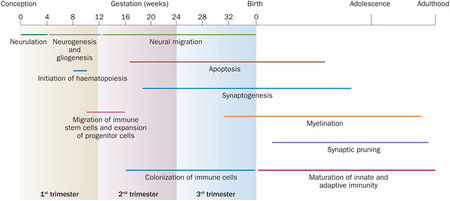Important Concepts
- During the first 6 years of life, the brain undergoes a period of rapid growth, increasing from 10% to 90% of adult volume. Most of this growth occurs before the age of two.
- Synaptic density, dopamine receptor density, and cerebral metabolic rates peak in the first 3 years of life and decline over subsequent decades (1).
- Neuronal migration involves extensive relocation of new neurons via glial cell tracks.
Myelination
From birth to age 5, the brain triples in mass from 350 g to a near-adult weight of 1.2 kg. Part of this increase is a result of the marked arborization and enhanced connection of neurons. Much of the gain stems from the vigorous myelination of fiber tracts (K&S 2009)
- Myelination is not completed until adulthood. This process corresponds with better motor coordination and faster information processing.
- Development of frontal lobes allows school-age children to better inhibit distracting stimuli and maintain focus on a particular task.
Pruning
- Synaptic pruning, or reorganization and elimination of cortical synapses, begins after birth and increases through adolescence. Pruning results in elimination of up to 50% of synapses that existed prior to puberty (synaptic connections are "overproduced" during synaptogenesis). Pruning correlates with ability to inhibit impulses, prioritize, and development of executive functioning
Pruning is evident in structural changes in the brain:
- decreased grey matter density (GMD) in dorsal aspect of frontal and parietal lobes between childhood and adolescence,
- further decrease in GMD in frontal cortex continues between adolescence and adulthood,
- there are increases in white matter density and volume until early adulthood.
Functional evidence of pruning includes declines in brain glucose metabolism, blood flow, and decreased EEG amplitude
Pathophysiology
Cerebral Palsy
Cerebral palsy as as a disorder of movement and posture, attributed to a CNS lesion or dysfunction that is not the result of a recognized progressive or degenerative brain disease. CP is a nonprogressive impairment. Intellectual functioning is not affected in children with cerebral palsy.
Fetal Alcohol Spectrum Disorder
This umbrella term, which includes the more severe Fetal Alcohol syndrome, is discussed in a dedicated article.
Research findings
Poverty
According to Luby, et.al., "poverty was associated with smaller white and cortical gray matter " (globally) and hippocampal and amygdala volumes (locally). Caregiver's support or hostility mediated hippocampal volumes bilaterally. The effects of poverty on hippocampal volume were mediated by stressful life events on the left.
Further Reading
(1) Gleason et. al. Psychopharmacological Treatment for Very Young Children: Contexts and Guidelines. JACAAP 46:12, 12,2007
(2) oan Luby, MD et. al., The Effects of Poverty on Childhood Brain Development The Mediating Effect of Caregiving and Stressful Life Events. JAMA Pediatr. 2013;167(12):1135-1142
